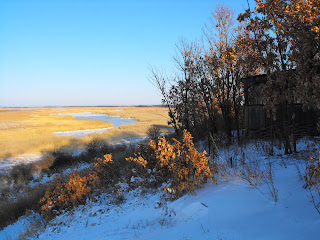
.JPG)
If anything good can be said about the wildfires at the park, is that the hazy smoke it puts into the atmosphere has a dramatic and beautiful affect on the sunsets, bringing out the vibrant colors of the spectrum:
Fortunately all the stork nests (we now know of 10 pairs that have begun to nest in and around the park) have been spared from the fires thus far. The storks have continued with their natural habits and have laid the first eggs this week and begun incubation.
We also located the nest of a pair of Red-crowned cranes. The female has chosen a nest site that makes her vulnerable to both fires and people and the park staff is contemplating on the best course of action to ensure that her offspring will survive this year. Red-crowned cranes are particularly sensitive to disturbance and we fear that in this location she may abandon her nest shortly.
At least three nests of the common kestrel have been observed in the park as well:
If you listen very intently in the reeds around the wetlands, you may hear the mating calls of Rana amurensis, our local frog. Many more have made their way to the surface and as the emerge, they breed and lay their large jelly-like egg masses in the shallow waters:
The first of the flowers are beginning to bloom in the fields as well:
I would like to end this week with a picture of a ground squirrel. These creatures can be found in the more northern portions of the park where they live in large communities. I had a chance to visit one of these communities this weekend and was greeted by this friendly face:




.JPG)











 In addition to butterflies, other insects have also begun to emerge. Some, I feel, will become more of a nuisance as spring turns into summer.
In addition to butterflies, other insects have also begun to emerge. Some, I feel, will become more of a nuisance as spring turns into summer.


 In closing, I would like to wish everyone a happy Easter! Yes you read correctly - Happy Easter! Easter was celebrated today (April 19, 2009) in Far-Eastern Russia; a week later than Easter in the United States.
In closing, I would like to wish everyone a happy Easter! Yes you read correctly - Happy Easter! Easter was celebrated today (April 19, 2009) in Far-Eastern Russia; a week later than Easter in the United States.




.JPG)


 Afterwards the students split into groups to go and view some of the birds in their natural habitats. Despite the lingering snow still present on the trail , everyone had a great time walking through the woods and scanning the wetlands for some of Muraviovka's special inhabitants:
Afterwards the students split into groups to go and view some of the birds in their natural habitats. Despite the lingering snow still present on the trail , everyone had a great time walking through the woods and scanning the wetlands for some of Muraviovka's special inhabitants: As the week progressed, nearly all of the snow has melted within the park. This has exposed long buried food sources and has allowed for travel in the wetland to be much easier. This has given rise to an explosion of animals that haved moved out of the cover of the forest to frolic and feed in the wetlands. Groups of pheasants, foxes, and roe deer can now be seen foraging in the valley below!!
As the week progressed, nearly all of the snow has melted within the park. This has exposed long buried food sources and has allowed for travel in the wetland to be much easier. This has given rise to an explosion of animals that haved moved out of the cover of the forest to frolic and feed in the wetlands. Groups of pheasants, foxes, and roe deer can now be seen foraging in the valley below!!